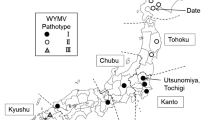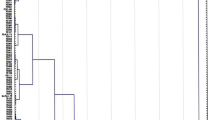Abstract
Wheat streak mosaic virus (WSMV) is one of the most important diseases limiting winter wheat (Triticum aestivum L.) production in the western Great Plains of North America. There is no known effective WSMV resistance within the primary gene pool of wheat. However, a resistance gene (Wsm1) has been transferred to wheat from a perennial relative, intermediate wheat-grass [Thinopyrum intermedium (Host) Barkworth & DR Dewey]. Nebraska-adapted winter wheat lines carrying Wsm1 were used to characterize the effects of this alien introgression on agronomic and quality traits. Sister-lines from six breeding populations were evaluated under virus-free conditions, and under a naturally occurring viral infection. In uninfected locations, no significant difference for grain yield was detected between resistant (R) and susceptible (S) lines, when averaged over populations, but resistant lines had significantly higher test weights. Within populations, significantly higher grain yield was observed only in population 1, while significantly higher test weights occurred in populations 1, 2, 5 and 6. At the infected location, resistant lines were significantly higher in yield in five of six populations. In two of six populations, susceptible lines were significantly higher in bread loaf volume and bake mix time, while in the remaining populations, no significant quality differences were observed. As the Wsm1 gene provided yield advantages under viral infection, and there was no yield detriment in the absence of the virus, its deployment in hard winter wheat cultivars merits consideration.
Similar content being viewed by others
References
American Association of Cereal Chemists (1983) Approved methods of the AACC. AACC, St. Paul, MN
Baley GJ, Talbert LE, Martin JM, Young MJ, Habernicht DK, Kushnak GD, Berg JE, Lanning SP, Bruckner PL (2001) Agronomic and end-use qualities of wheat streak mosaic virus resistant spring wheat. Crop Sci 41:1779–1784
Dweikat I, Zhang W, Ohm H (2002) Development of STS markers linked to Hessian fly resistance gene H6 in wheat. Theor Appl Genet 105:766–770
Federer WT, Raghavarao D (1975) On augmented designs. In Biometrics 31:29–35
Friebe B, Gill KS, Tuleen NA, Gill BS (1996) Transfer of wheat streak mosaic virus resistance from Agropyron intermedium into wheat. Crop Sci 36:857–861
Graybosch RA (2001) Uneasy unions: Quality effects of rye chromatin transfers to wheat. Journal of Cereal Science 33:3–16
Hunger R (2004) Wheat streak mosaic virus prevalent in Western Oklahoma and the Panhandle. Plant Disease and Insect Advisory 3(7), Oklahoma State University, http://entoplp.okstate.edu/Pddl/advisory.htm
Lee JH, Graybosch RA, Peterson CJ (1995) Quality and biochemical effects of a BL/1RS whet-rye translocation in wheat. Theor Appl Genet 90:105–112
Lookhart GL, Bean SR, Graybosch R, Chung OK, Morena-Sevilla B, Baenziger S (1996) Identification by high-performance capillary electrophoresis of wheat lines containing the 1AL.1RS and the 1BL.1RS translocation. Cereal Chem 73(5):547–550
Seifers DL, Martin TJ, Harvey TL, Gill BS (1995) Temperature sensitivity and efficacy of wheat streak mosaic virus resistance derived from Agropyron intermedium. Plant Dis 79:1104–1106
Sharp GL, Martin JM, Lanning SP, Blake NK, Brey CW, Sivamani E, Qu R, Talbert LE (2002) Field evaluation of transgenic and classical sources of wheat streak mosaic virus resistance. Crop Sci 42:105–110
Steel RGD, Torrie JH (1980) Principles and procedures of statistics. McGraw-Hill Book Company, New York, NY, USA
Talbert LE, Bruckner PL, Smith LY, Sears R, Martin TJ (1996) Development of PCR markers linked to resistance to wheat streak mosaic virus in wheat. Theor Appl Genet 93:463–467
Wells DG, Wong RS, Lay CL, Gardner WS, Buchenau GW (1973) Registration of CI 15092 and CI 15093 wheat germplasm. Crop Sci 13(6):776
Wells DG, Kota RS, Sandhu HS, Gardner WS, Finney KF (1982) Registration of one disomic substitution line and five translocation lines of winter wheat germplasm resistant to Wheat Streak Mosaic Virus. Crop Sci 22(6):1277
Author information
Authors and Affiliations
Additional information
Joint contribution of the United States Department of Agriculture, Agricultural Research Service and the Department of Agronomy, University of Nebraska-Lincoln as Journal Series Paper No. 15066. Mention of firm names or trade products does not imply that they are endorsed or recommended by the USDA or the University of Nebraska over other firms or products not mentioned.
Rights and permissions
About this article
Cite this article
Divis, L.A., Graybosch, R.A., Peterson, C.J. et al. Agronomic and quality effects in winter wheat of a gene conditioning resistance to wheat streak mosaic virus. Euphytica 152, 41–49 (2006). https://doi.org/10.1007/s10681-006-9174-8
Received:
Accepted:
Published:
Issue Date:
DOI: https://doi.org/10.1007/s10681-006-9174-8




